Ours is not to reason why, just invert and multiply. WHY!
Keep Change Flip WHY!
My district’s focus, this year, has been conceptual understanding. Therefore my coaching colleagues and I have been searching for a clear explanation to why we invert and multiply. In the process, beside our numerous in depth geeky conversations, we’ve become proficient at solving division of fraction problems multiple ways – Drawing pictures being my favorite method. I can describe which parts of the picture represents the division process. But if someone were to ask me, “Why do we have to flip the second fraction?”, I’d still stumble over the explanation.

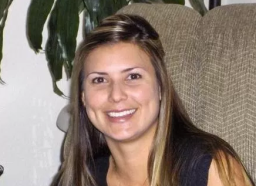
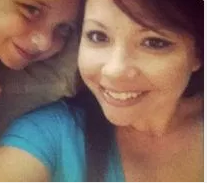
My colleagues: Tim, Mari and Karon
Recently, a series of experiences connected with earlier conversations have me believing I’m getting close to a clear explanation. Here’s my attempt to shed light on the situation …
**************************************************************
Groups vs Group Size
Synapses started firing when using Nat Banning‘s website, FractionTalks.com. While leading a FractionTalks activity, the language of groups and group size started swirling around in my head. My “aha” moment: Groups and group size are reciprocal concepts.
Groups: 2 Groups: 3 Groups: 4
Group Size: 1/2 Group size: 1/3 Group size: 1/4
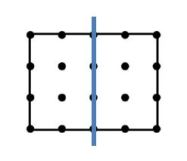
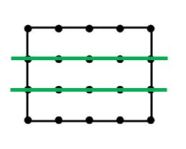
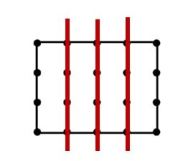
The given FractionTalks.com prompt: How many ways can you divide into … lead into other questions.
- How many ways can you section the rectangle into halves? More than 1
- How many groups did you end up with? (2)
- How many squares make up each group? (6)
- How many squares are found in 1/2 the rectangle? (6)
- How many squares are found in the group size of 1/2? (6)
*********************************************************************
Classroom Example
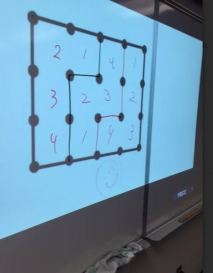
- How many ways can you divide the rectangle into thirds? (Many)
- How many groups did you end up with? (3)
- How many squares make up each group? (4)
- How many squares are found in 1/3 of the rectangle?(4)
- How many squares are found in the group size of 1/3? (4)
***********************************************************************
Equal Sharing
 At a recent Anni Stipek training, we were presented with the following problem:
At a recent Anni Stipek training, we were presented with the following problem:
Patrick had 1/4 of his birthday cake left. If he shared it equally among himself and 2 friends, how much of the birthday cake will each one get?
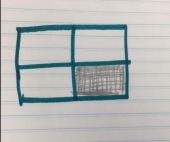
Step 1: I drew my picture and wrote the expression, 1/4 ÷ 3. When a fraction is divided by a whole number, the concept of equal sharing is applied. The shaded part represents 1/4 of the cake.
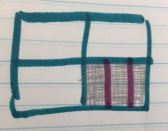
Step 2: The remaining 1/4 of the cake is split into 3 sections b/c we have 3 people. Each section represents a group size of 1/3. I get to eat 1/3 of the remaining 1/4 of cake.
I split the 1/4 into 3 groups which means my share represents the group size of 1/3. This acknowledgement addresses why we write the reciprocal of the second number.
1/4 ÷ 3 (3 groups) now becomes
1/4 • 1/3 (group size of 1/3 of the 1/4 remaining cake)
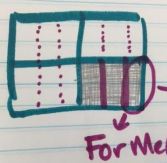
Step 3: The portion of the original cake that I get to eat is 1/12
1/4 • 1/3 = 1/12 of the original cake
***********************************************************************
Understanding what’s truly being asked.
I’d like to go back to the original problem and refine the question:
Original Problem: Patrick had 1/4 of his birthday cake left. If he shared it equally among himself and 2 friends, how much of the birthday cake will each one get?
Rewritten: Patrick had 1/4 of his birthday cake left. If he shared it equally among himself and 2 friends, What portion of the remaining cake will my piece represent when compared to the whole cake?
- Understanding the question: When I rewrote my question, I’m acknowledging that I need to find how my share compares to the whole cake. I have to compare the same ideas, which in this case is group size of my share to the size of the whole cake.
- Step 1: 1/4 ÷ 3. Divided the remaining cake into 3 groups.
- Step 2: Step 2 inverts the language. Groups and group size are reciprocal concepts. To answer our question, our answer needs to be in the context of size. Therefore we have to invert the concept of the groups to use the language of group size.
- Step 3: 1/4 of the remaining cake • my share (1/3) = the part of the whole cake that my piece represents. (1/12) or 1/4 • 1/3 = 1/12

This process emphasizes the importance of relating the answer back to the whole.
***********************************************************************
Repeated Subtraction
Let’s continue with the cake theme to discuss the repeated subtraction approach.
Denise brought her remaining 3/4 cake, to work, to share with friends.
Given this scenario, let’s tackle the problem: 3/4 ÷ 1/8
If we use the equal sharing method, this problem says Denise is going to split the remaining 3/4 of cake among an 1/8 friend. Huh? That statement doesn’t make any sense. There has to be at least 1 whole person in which to share the cake. Since we don’t have at least 1 whole person, the equal sharing method isn’t appropriate in this scenario.
The equal sharing approach is used when dividing by a whole number. 1/8 is not a whole number. It’s a fraction, therefore we have to apply the repeated subtraction process.
In this problem, the 1/8 represents the size of the piece in comparison to the whole cake. Therefore, we need to determine how many groups of size 1/8 fit into 3/4 of the cake. The process of determining the number of groups makes this is a repeated subtraction problem.
Let’s start over using the repeated subtraction approach. Denise brought to work her remaining 3/4 cake to share with friends. If each person gets a piece representing 1/8 of the whole cake, how many people can get a piece?
3/4 ÷ 1/8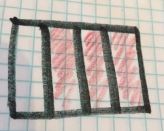
Step 1: I drew a rectangle and shaded in 3 out of the 4 sections
Step 2: Now to find sections of 1/8 …
- Question: But how do I determine how much is 1/8?
- Answer:
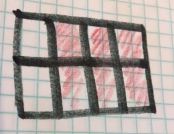
- We need 8 groups to clearly see a group size of 1/8. Here’s the reciprocal aspect coming into play. By inverting the size of 1/8 to 8/1, we are now talking about groups
- Once the number of groups is acknowledged (8), we have a clear visual of the size, 1/8
Step 3: 3/4 of 8 groups is 6 groups
- 3/4 ÷ 1/8 means, How many groups of size 1/8 are found within 3/4?
- 3/4 • 8/1 By establishing 8 groups, we can determine how many of those 8 groups is represented by 3/4. Or … What is 3/4 of 8 groups?
***********************************************************
Visually – Drawing a Picture
The explanation starts off the same …
3/4 ÷ 1/8
Step 1: Draw a rectangle and shade in 3 out of the 4 sections
Step 2: Now to find sections of 1/8
- Question: But how do I determine how much is 1/8?
- Answer: Since we are looking for groups of size 1/8, common denominators are needed. Therefore 3/4 ÷ 1/8 becomes 6/8 ÷ 1/8
Step 3: Now it’s clear how to determine the size of 1/8. When the number of groups needed is applied, the process of finding groups of size 1/8 is easier to see.
- Back to our question: How many 1/8’s fit into 6/8?
- Answer: 6 groups of 1/8 fit inside 6/8

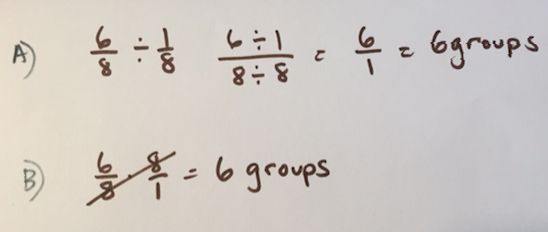
Analysis:
A: The work shown in A doesn’t show a reciprocal Here’s my thinking… By converting to common denominators, the group amount issue is addressed.
B: The work in B shows the reciprocal action of switching from group size (1/8) to number of groups (8).
***********************************************************************
Summary
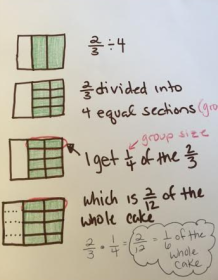
Dividing by a whole number 2/3 ÷ 4
- Equal sharing
- Division means separation into equal groups
- Answer is a size compared to the whole
My answer of 2/3 ÷ 4 represents the portion of the whole cake that I receive. 4 people are eating the remaining 2/3 of the cake.
Each person received 1/6 of the cake.
1/6 • 4 = 4/6 = 2/3
(Size of a piece) • (Number of people) = Amount of cake shared
****************************************************************
Dividing by a fraction 2/3 ÷ 1/4
- Repeated subtraction
- Division means finding the number of groups of the given size
- Answer represents the number of groups found.
Mari brought in 2/3 of her remaining birthday cake. If the 2/3 is split into a portion size of 1/4, is it possible for Karon, Tim, JJ & Jenn to all get cake?
Method 1
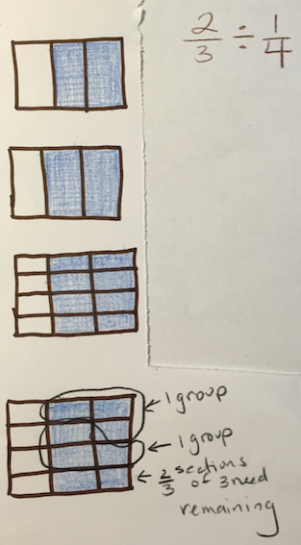
2/3 ÷ 1/4: How many groups of 1/4 fit inside 2/3? Can Karon, Tim, JJ and Jenn all receive cake?
Since we are dividing by a fraction (group size 1/4) we need to determine the group number we are working within. Converting to common denominators will do that.
We now have 8/12 ÷ 3/12, which means: How many groups of 3/12 fit inside 8/12?
The context of 12 has been established, I can look for groups of 3/12ths. I circled 2 full groups of 3/12. There were 2 sections of the remaining 3 needed, resulting in an answer of 2 2/3 groups
Answer: 2 2/3 people (groups) can get a piece of cake.
For this problem, Karon and Tim will each receive cake. J.J. will receive a partial portion. No cake for Jenn.
Karon and Tim’s pieces represent 1/4 of the cake. J.J piece represents 1/6 of the cake.
********************************************
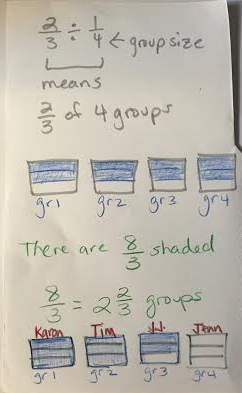 Method 2
Method 2
Because the above method, used common denominators to acknowledge the group context. I did the problem again to clearly show the reciprocal action of changing the 1/4 size to 4 groups.
This format clearly shows the division of cake among Karon, Tim, JJ and Jenn. Karon and Tim get full pieces. JJ gets a partial portion. Again, no cake for Jenn.
Conclusion
The conversations with my colleagues, the trainings I’ve attended, the search to understand keep, change, flip conceptually and the writing of this post have all helped me unravel some of the fascinatingly complex and intriguing aspects of fractions. I can confidently say, my understanding of fractions has grown but I still have a lot to learn.
***********************************************************************
Fraction Related Posts
- Progressions: Fraction Fact Families
- Comparing Fractions w/ Desmos
- Desmos: Ordering Fractions on a Number Line


Pingback: Comparing Fractions w/ Desmos | Communicating Mathematically
Pingback: Progressions: Fraction Fact Families | Communicating Mathematically
Pingback: Desmos: Ordering Fractions on a Number Line | Communicating Mathematically
Try this division of two fractions: 3/4 divided by 2/3 and display the solution visually similar to above.
I read an NCTM article a few years that showed a visual solution but it was not appealing to me.
I later developed my own and saved a few examples if you are interested.
LikeLiked by 1 person
I’m definitely interested! Plz send to jgvadnais@gmail.com. Thank you.
LikeLike
For division of fractions, how about the partitive method?
2/3 ÷ 1/4 = ?
Translates as
2/3 = 1/4 of what size group?
Draw a circle cut into 1/4’s.
Shade one quarter, and write 2/3 in that quarter.
The size of the whole is immediately evident as 4 lots of 2/3
To help kids “see” the problem, have them write down a whole number example first, using the partitive model:
6 ÷ 2 = ?
Translates as
6 = 2 groups of what size group?
LikeLiked by 1 person
Thank you for your sharing your suggestion, Master Blaster! It caused me to grab some paper, create a few drawings and experiment with harder problems, such as 3/4 divided by 2/3. Yes, once the circle is filled in, “seeing” the value of 1 whole is clear. It was for me!! And I agree, starting with whole number examples acclimates students to this way of thinking through the fraction version. Will be passing your example on to elementary friends of mine. 🙂
LikeLike
Sorry its a bit lengthy, but here are some further observations with the partitive method:
(1) If the whole circle represents something tangible, the division problem becomes even clearer. For example – 2/3 of a cake fits into 3/4 of a container, how much cake fills the whole container? The “whole” represents the container.
(2) In solving the above example (cake and container), 2/3 of cake is split into 3 pieces (multiply by 3/3 to achieve this, thus using equivalent fractions). Then to fill the whole, one of the pieces is multiplied by 4, to fill the 4 quarters. This operation is “invert and multiply”. i.e. (÷3 x4) = x(4/3).
(3) I have found some questions where I wasn’t able to create a tangible meaning for the whole, and follow this process. For example “I have 2/3 of a metre of fabric, and 3/4 of a metre of fabric makes one dress. How much of 1 dress can I make with 2/3 of a metre?”
Even though the answer to the dress question is the same as the cake/container question (i.e. 2/3 ÷ 3/4), I can’t find a way to make the whole (the circle) have a tangible meaning in the dress question. What I realised, after thinking about it a while, was that the circle method holds tangible meaning when the question is asking how much of something “fits” into a “whole” of something else.
If you draw a small table of numbers with headings, representing the known information and the unknown, there is typically (always?) 3 knowns and 1 unknown. Eg In the cake container question the headings would be “Cake” (left column) and “Container” (right column). The numbers in the first row would be “2/3” and “3/4”. The numbers in the second row would be “?” and “1”. The whole always represents the item which is number “1” in the second row. This may help kids understand (see) which item is the whole.
Back to the dress question, if I use the table approach, but get to the answer in a 2 step approach rather than a single step, the whole can be represented by something tangible. The headings would be “Metres of fabric” and “Amount of dress”. The first row would be “3/4” and “1”. For the second row choose to put “1” and “?”. The whole then represents 1 metres of fabric. To get the answer for how much of a dress can be made with 2/3 of a metre, the second step is to multiply by 2/3.
LikeLike
I’ve started creating pictures that match your examples. I really wish I could upload a picture into a comment!!
LikeLike
Master Blaster, I started back at work this week. Looking forward to this weekend to read, digest and respond to your observations. Til then. 🙂
LikeLike
In regard to uploading an image into a comment, does the link below work at your end?
There are probably multiple programs that can do similar, however I have used Evernote to create an HTML file containing an image of what I was sketching when I was thinking about partitive division.
https://www.evernote.com/shard/s715/nl/134865775/a1d3026b-5cb8-424f-88d7-5a65c3949fc1/
LikeLike
I was unable to access the evernote picture, so I made a google doc. My question to you is in part B. Here are my pictures. https://docs.google.com/document/d/1duxyl-PmdU4Djgk21JE-Z7sOLXj678PWxM6yzXRzGSg/edit?usp=sharing
LikeLiked by 1 person
I’m not sure how I can “reply” within the conversation above, so keep starting a new conversation.
I got your documents through the Google Docs link.
The Evernote link I sent previously should work now. I didn’t realise I had to tick a box (on the note saved in my Evernote account) to make the note publicly accessible. I have done that now.
In regard to your question in Part B:
(1) I have created a second Evernote link showing the same example (3/5 ÷ 1/3)
https://www.evernote.com/l/AsvxRvPrUOBDGpvLc5OYIx-I0ildQpE9SQE
(2) Try showing the question side by side with a question that does not involve fractions. With whole number division (using the partitive method), the question is – how much (of the dividend) ends up in “1 whole group”. The same question applies to fraction division questions – “how much (of the dividend) ends up in 1 whole group?”.
(3) I think it helps (visually) to shade the part of the whole that represents the divisor. That then shows how many parts the dividend needs to be split into. In the whole number division (6 ÷ 2), I shaded 2 whole groups.
(4) You seem to have shaded a fraction bar that represents the dividend of 3/5. I suggest shading the portion of the whole that represents the divisor, i.e. 1/3. This then shows how many parts the dividend needs to be split into, in order to be put into the shaded portions. This is noting that, under the partitive method, the question is saying “3/5 = 1/3 of a group of what size?”
(5) After splitting up the dividend into the required number of parts, and distributing them into the shaded portion, I would leave the image alone after that – as it represents the question. It shows a scenario of 3/5 fitting into 1/3 of a group.
(6) To get to the answer, it might be worth drawing the group again, and putting 3/5 into each of the other two “empty” thirds. Alternatively, without pictures, multiply what’s in the “one third” by 3, to obtain what is in the whole (this is the link to invert and multiply)
(7) When the question involves fractions that are not unit fractions, and more than one portion of the whole is shaded (e.g. 2/3 ÷ 3/4 – has 3 shaded portions of the whole) – dividing the 2/3 into 3 pieces, in order to distribute them evenly into the 3 shaded portions – is the other component of the process that links with the invert and multiply rule.
_________________________________________
As an aside, I was talking with an elderly gentleman recently, and he said something that I asked him to repeat, to make sure I had heard him correctly. He said:
“Ours is not to reason why. Ours is but to do or die”
I asked him where that saying came from, and he said it was from soldiers in war. What he meant when he used it, was simply to say that its best not to ask why we need to do something (we have been told to do), but just do it.
Ironic on two counts, with regard to the saying as modified in the teaching of maths.
LikeLike
I think I have it!! I’ver written out and drew pictures for several examples. https://docs.google.com/document/d/1duxyl-PmdU4Djgk21JE-Z7sOLXj678PWxM6yzXRzGSg/edit?usp=sharing
LikeLike
That looks like it.
I think the terminology used is slightly different.
For example 6 ÷ 1/2: = ?, reads as
“6 = 1/2 a group of what size?”
Rather than
“If 6 were put into 1/2 a group, then the whole would be?”
This would be because of the link with the word “of” and multiplication.
For a good discussion on this topic, see the following blog:
I would be interested to hear whether it’s clear to kids (taught the partitive way).
The quotative method of counting comes more naturally.
eg 6 ÷ 1/2 = ? means:
How many 1/2’s are there in 6?
But, the quotative method doesn’t seem to link with invert and multiply very easily.
Also, its hard to count how many 2/3 are in 3/4, etc (can be done, but somewhat arduous).
See you in future maths discussions.
I am a structural engineer (30 years in the construction / consulting industry), but recently completed a graduate diploma in education. I will probably head into teaching in a couple of years. On one of my practicums during the course, one kid couldn’t answer for me the question of 2 ÷ 2 = ?. It was just me and him, not the whole class. At that point I realised I had nothing to offer him, so began the process of trying to understand maths conceptually. Division is a fundamental concept to get down. I had read about p and q division, but it always made me glaze over with disinterest. I couldn’t see the point in thinking about a division problem in two ways. When I read the blog by Denise Gaskin (for the 3rd or 4th time), I realised there was a way to make the process of partitive division quite tangible. i.e. When the whole “group” represents something physical (like a cake tin).
Cheers
Tom
LikeLike
Tom,
Thank you for reaching out and opening my eyes to another way of explaining division. I’ve already continued our conversation with colleagues who enjoy discussing the division of fractions as much as we do.
Take care,
Jenn V
LikeLike